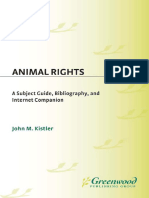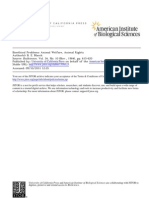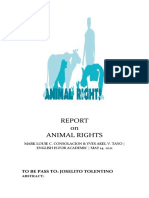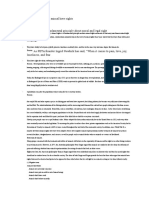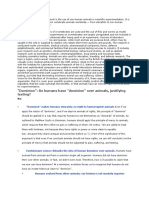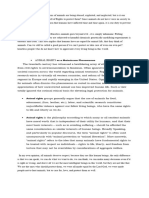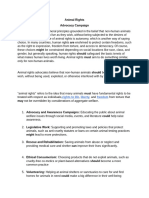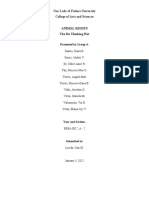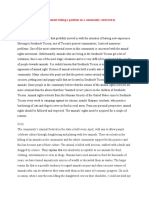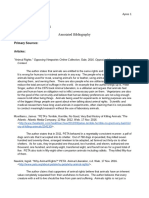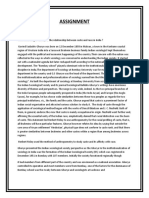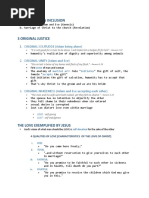Animal Welfare, Animal Rights
Animal Welfare, Animal Rights
Uploaded by
DevynCopyright:
Available Formats
Animal Welfare, Animal Rights
Animal Welfare, Animal Rights
Uploaded by
DevynCopyright
Available Formats
Share this document
Did you find this document useful?
Is this content inappropriate?
Copyright:
Available Formats
Animal Welfare, Animal Rights
Animal Welfare, Animal Rights
Uploaded by
DevynCopyright:
Available Formats
Animal Welfare, Animal Rights: The Past, the Present, and the 21st Century
Author(s): Morton S. Silberman
Source: The Journal of Zoo Animal Medicine , Dec., 1988, Vol. 19, No. 4 (Dec., 1988), pp.
161-167
Published by: American Association of Zoo Veterinarians
Stable URL: https://www.jstor.org/stable/20094884
JSTOR is a not-for-profit service that helps scholars, researchers, and students discover, use, and build upon a wide
range of content in a trusted digital archive. We use information technology and tools to increase productivity and
facilitate new forms of scholarship. For more information about JSTOR, please contact support@jstor.org.
Your use of the JSTOR archive indicates your acceptance of the Terms & Conditions of Use, available at
https://about.jstor.org/terms
American Association of Zoo Veterinarians is collaborating with JSTOR to digitize, preserve and
extend access to The Journal of Zoo Animal Medicine
This content downloaded from
27.34.246.202 on Tue, 29 Aug 2023 04:18:27 +00:00
All use subject to https://about.jstor.org/terms
Journal of Zoo Animal Medicine 19(4): 161-167, 1988
Copyright 1988 by American Association of Zoo Veterinarians
EDITORIAL
ANIMAL WELFARE, ANIMAL RIGHTS: THE PAST,
THE PRESENT, AND THE 21ST CENTURY
Morton S. Silberman, D.V.M.
Abstract: Enactment of animal welfare legislation and the characteristics these laws have taken
parallel the evolution of the animal welfare and humane movement. As we move into the 21 st
century, zoological collections, wildlife management activities, and the entire spectrum of captive
animal management will be challenged to meet new standards.
Key words: Animal welfare, rights, laws, humane.
INTRODUCTION methodology and a reduction in animal
numbers.
One can speculate that concern for an an
The second movement centers around
imal's well-being originated with the cap
those groups advocating animal rights. This,
tive management of a variety of species.
however,
Concepts of what "well-being" represents is not a new issue; the zeal, energy,
have changed with the ages, but it would and
be financial support it is receiving is a 20th
century
hard to believe that even during the earliest phenomenon. In general, groups that
captive rearing of animals certain humane support this principle see animals attaining
principles were not invoked. Husbandry thatthe same rights, short of voting, that hu
promotes well-being is a synonym for mans
hu have. They would like to see the cap
mane treatment. tive care of animals and all biom?dical re
There has been an evolution in the wholesearch come to an end, and the human race
to turn to vegetarianism. Some of these
vista of what traditionally was considered
groups support clandestine and covert ac
humane care and treatment of animals. This
has developed into two main movements, tivities against biom?dical and agricultural
entities. One must understand that there is
some suggesting a third middle movement
no left-center-right in the humane move
that borrows from both ends of the spec
ment. The traditional humane organiza
trum. One movement is that of the tradi
tions are, for the most part, moderates or
tional humane interest groups who feel that
their goals embody an enhancement of an centrists. The overwhelming number of ac
imals' life quality. They care for stray anitivists are to their right; some could even
be termed extremists.
mals, fight animal abuse (i.e., unsatisfactory
housing, poor nutrition, physical torment, The questions we pursue here are do we
etc.), and generally concern themselves withneed more animal advocacy groups, do we
"quality of life" issues. In general these need more laws, or will the enthusiastic and
groups are not against biom?dical research, ethical enforcement of existing statutes meet
the public's wishes for humane care and
zoos, or food animal production. Without
treatment?
question, they favor excellent treatment of
animals, the cessation of what they deem
needless animal use, and they want the re HUMANE MOVEMENT IN THE
UNITED STATES:
search community to strive for alternative
AN HISTORICAL PERSPECTIVE
From The Robert W. Woodruff Health Sciences For all practical purposes, it was the mid
Center, Emory University, P.O. Drawer KK, Atlanta, to late 19th century when organized efforts
Georgia 30322. addressing the humane care and treatment
161
This content downloaded from
27.34.246.202 on Tue, 29 Aug 2023 04:18:27 +00:00
All use subject to https://about.jstor.org/terms
16 2 JOURNAL OF ZOO ANIMAL MEDICINE
of animals started to come to the forefront. imals (FFA). During 1977, the Committee
Organized humane groups started to appear for Humane Legislation (CHL) was formed,
in Great Britain and the United States. With joining, at least philosophically, with SAPL
Henry Bergh's inception of the American to promote legislation that would affect the
Society to Prevent Cruelty to Animals treatment of farm and other captive ani
(ASPCA) in 1869, the organized humane mals.
movement began. The movement now Groups comprised of members from the
numbers over 7,000 groups. various professions started to appear and
The American Humane Association philosophical separation of humane thought
(AHA) officially opened its doors in 1877, became more defined. In 1979, Attorneys
offering a concept of humane treatment for for Animal Rights, later to become The An
children as well as animals. This concept imal Legal Defense Fund (ALDF) became
that children, as well as animals, are de a viable group. Closely thereafter followed
serving of humaneness persists in AHA un the Medical Research Modernization Com
til this date, making it rather unique in a mittee (MRMC), National Association of
world that finds kindness and caring ever Nurses Against Vivisection (NANAV), Psy
more secular. By 1883, concerns with med chologists for the Ethical Treatment of An
ical research surfaced openly and the Amer imals (PsyETA), Physicians Committee for
ican Antivivisectionist Society (AAS) was Responsible Medicine (PCRM), and Asso
founded. This was followed in 1899 by the ciation of Veterinarians for Animal Rights
American Humane Education Society (AVAR). The 1980's will probably go down
(AHES), bringing the humane movement in history for being the "Era of Animal
vigorously into the 20th century. Rights Activist Genesis," when groups like
As the 1900's progressed, antivivisection the Animal Political Action Committee
and humane treatment became synony (ANPAC), Animals in Politics (AIP), Na
mous in many quarters. By 1911, the New tional Alliance for Animal Legislation
York Antivivisectionist Society (NYAS) was (NAAL), Mobilization for Animals (now
founded. In both Europe and North Amer defunct), United Action for Animals (UAA),
ica, particularly Great Britain and the United Human/Animal Liberation Front (HALF),
States, the antivivisectionist movement Culture and Animals Foundation (CAF),
started on its road to a distinct identity free and the Voice of Nature Network (VNN)
from the traditional motivations of the all had their origin. The last four organi
moderate humane organizations. Groups zations have particular significance, with
like the New England Antivivisectionist So both UAA and HALF monitoring the re
ciety (1896) came into being, furthering a search community, CAF sponsoring artists
course away from "main-stream" humane and writers who through their endeavors
concepts. In 1952, the Animal Welfare In show a feeling for animals, and VNN pro
stitute (AWI) appeared, expounding better ducing animal rights propaganda for mass
conditions for research and farm animals. circulation. Most recently, a group calling
Active to date, the organization has proved itself Disabled Against Animal Research
influential in many circles, particularly the and Exploitation (DAAFE) has formed,
federal legislature. Shortly after AWI, the probably in response to the proresearch
Humane Society of the United States group called Incurably 111 for Animal Re
(HSUS) opened its doors in 1954 in Wash search (IIFAR). The International Fund for
ington, D.C. By 1955, the Society for Ani Animal Welfare (IFAW), Friends of Ani
mal Protective Legislation (SAPL) was born, mals (FOA), International Society for An
beginning a history of exerting influence by imal Rights (ISAR), and Greenpeace are also
lobbying Congress. In 1967, Cleveland major organizations in today's animal rights
Amory formed his group, the Fund for An scenario.
This content downloaded from
27.34.246.202 on Tue, 29 Aug 2023 04:18:27 +00:00
All use subject to https://about.jstor.org/terms
SILBERMAN- WELFARE, RIGHTS: PAST TO FUTURE 163
Of particular interest in this evolution of Research (NAMR?now defunct) was
animal activism is the formation of People formed in 1949. It attempted to expound
for the Ethical Treatment of Animals on the virtues of medical research and an
(PETA). PETA is rapidly becoming the swer the growing antivivisectionist move
driving force of the activist movement. With ment. Essentially, this was the only advo
the appearance of PETA, the Animal Lib cacy group on their side of the aisle. Shortly
eration Front (ALF) made its first appear after, in 1950, the American Association for
ance in the United States. This group is the Laboratory Animal Science (AALAS) took
U.S.'s version of the British Animal Lib root, but to this date serves more as a dis
eration Front (BALF). PETA has acted as seminator of knowledge to the biom?dical
the spokesman for ALF activities, many of community than as an advocacy group. The
which are covert and illegal in the U.S. other groups that followed, Institute for
Of particular interest to those involved in Laboratory Animal Resources (ILAR) in
zoological gardens and parks is the emer 1952, the American College of Laboratory
gence of the British organization known as Animal Medicine (ACLAM) in 1957, the
ZOOCHECK. They have been active American Association for the Accreditation
throughout Europe and parts of Africa. of Laboratory Animal Care (AAALAC) in
Presently, they have a branch in Canada, 1965, the American Association of Labo
and one can expect them to move into the ratory Animal Practitioners (ASLAP) in
U.S. in the near future. Their objectives are 1967, and the American College of Zoolog
unclear at the present time. In Canada they ical Medicine (ACZM) in 1985, were all de
have stated goals that could stand the test signed to educate and attest to the ability of
of anyone interested in quality zoos. How peers to oversee the quality of animal re
ever, the concern is if their desire is truly search or captive animal husbandry. The
for "good" zoos or rather to organize to American Association of Zoo Veterinarians
close all zoological collections. (AAZV) is the oldest of the groups and serves
as a conveyer of knowledge to peers rather
THE BIOMEDICAL RESEARCH
than serving in an advocacy position.
ADVOCACY
Within existing professional groups, such
Researchers, zoo directors, and farmersas the United States Animal Health Asso
have had a tradition of "ostrichism" when ciation (USAHA), American Association of
it comes to defending their positions and Zoological Parks and Aquariums (AAZPA),
tend to react only to immediate crises. In and the American Veterinary Medical As
my opinion, they have suffered the bane ofsociation (AVMA), interest in and concern
the well educated when dealing with their for humane issues have manifested them
"lesser" counterparts in society, an extremeselves by the formation of animal welfare
egoism that cures all attacks from the uncommittees.
initiated. So, though the humane move During 1985, the then sole advocacy group
ment has grown (as previously stated to overon a national level was formed by the amal
7,000 organizations in the U.S. alone), less gamation of the previously mentioned
than 50 groups support the advocacy of anNAMR and the Association for Biom?dical
imal research and the captive rearing of anResearch (ABR). This new group calls itself
imals. Without question, these groups arethe National Association for Biom?dical
for the most part advocates of humane an Research (NABR). An educational arm, the
imal care and treatment. The great majority Foundation for Biom?dical Research (FBR),
of the membership that makes up these ad has been created to support NABR activi
vocacy groups are humanists in the finestties. Presently, a handful of states have
tradition. biom?dical research associations. By 1986,
The National Association for Medical the previously noted group, Incurably 111 for
This content downloaded from
27.34.246.202 on Tue, 29 Aug 2023 04:18:27 +00:00
All use subject to https://about.jstor.org/terms
164 JOURNAL OF ZOO ANIMAL MEDICINE
Animal Research, evolved. This then be forcement responsibilities assigned to the
came the second national advocacy group United States Department of Interior
for the biom?dical community. (U.S.D.L). This Act gave minimal protec
tion to wild horses, which apparently did
AN ABRIDGED HISTORY OF not satisfy anyone.
ANIMAL WELFARE LEGISLATION
During the 1960's, horror stories about
(CANADA AND UNITED STATES) puppy mills and accusations of selling stolen
Most historians credit the Cruelty to An dogs to research facilities became rampant.
imals Act, passed by Parliament in Great The SAPL actively sought legislation to ad
Britain in 1876, as the precursor of animal dress these issues, receiving great support
welfare legislation in the Western world. from a Life Magazine issue in 1965 that
This Act regulates experimentation on liv showed pictures of a particularly horrible
ing vertebrates (excluding man) if such stud puppy mill on its front page. Despite cries
ies will cause pain. Contrary to the opinion of the ultimate demise of biom?dical re
of many, particularly outside of Great Brit search from the scientific community, Con
gress passed, in 1966, what was to become
ain, this was not a welfare act in the truest
known as the Animal Welfare Act (P.L. Law
sense. Also, often forgotten, the Congress of
the United States passed the so-called "28 89-544), and the U.S.D.A. was charged with
Hour Law" in 1873, 3 yr before the British its regulation. To date, this is the most im
Act. This law is still active, dealing with the portant animal welfare legislation passed in
movement of cattle by railcar and the need the U.S. The Law was amended in 1970,
to rest, feed, and water them every 28 hr. 1976, and 1985. This Act created categories
Indeed, this Law even preceded by a num of licensure, Dealer, Exhibitor (most zoos
ber of years the first laws giving the United fit this category), and Research Institutions.
States Department of Agriculture (U.S.D.A.) The Act gives great discretionary power to
authority to study animal diseases. the Secretary of Agriculture to regulate the
It was not until 1911, with Parliament's species he or she deems appropriate. To date,
passing of the Protection of Animals Act, farm animals and laboratory rats and mice
that regulations on a national level were en are not regulated. There is no question that
acted to deal with cruelty to domestic and the original law and its amendments have
captive animals. Since then, Britain has had a positive effect on the entities regulat
passed more than 20 laws dealing with re ed; unfortunately, it has satisfied few. Sci
search or humane treatment of animals at entists feel encroachment by those they deem
the national level. "not qualified" to regulate their activities,
At the national level in the U.S., a great most "centrists" feel the law has been poor
hiatus developed between passage of the "28 ly administered, and the activists see no val
Hour Law" and the next national legislation ue in it as it sets regulations for activities
that would deal with animal welfare. Al they feel should be abolished.
most 60 yr later, in 1948, legislation was The Wild, Free-Roaming Horses and
passed that allowed the United States Cus Burros Act passed in 1971 gave regulatory
toms officials to set some standards for ship strength to the Wild Horse Annie Act. An
ping animals. The Humane Slaughter Act imals on government land are protected. The
(1958) was the next major humane bill to Act gives the Bureau of Land Management
pass the Congress. It was addended in 1978. (B.L.M.) of the U.S.D.L the right to place
This legislation only applies to the humane surplus animals with qualified individuals.
slaughter of animals, but it brought signif Of particular significance to zoological
icant improvement to the industry. It is ad parks and aquaria was the passing of the
ministered by the U.S.D.A. In 1959, the Marine Mammal Protection Act in 1972.
Wild Horse Annie Act was passed with en The Department of Commerce was given
This content downloaded from
27.34.246.202 on Tue, 29 Aug 2023 04:18:27 +00:00
All use subject to https://about.jstor.org/terms
SILBERMAN-WELFARE, RIGHTS: PAST TO FUTURE 165
the responsibility to enforce this law, but binding guidelines for various aspects of an
marine mammal care standards were in imal research.
corporated in the Animal Welfare Act stan SOME NOTES ON ANIMAL
dards, thus placing enforcement with the WELFARE LEGISLATION
U.S.D.A. This Act has not been enforceable WORLDWIDE
at times and incursions go unpunished be
As previously noted, Great Britain has a
cause of loopholes and the vast area cov
number of laws designed to protect animals,
ered. It was this Act that made the polar
particularly in the research environment.
bear (Thalarctos maritimus) a marine mam Those of interest are:
mal, at least in a legal frame.
The Endangered Species Act, one of the 1. Dogs Act (1906) prohibits dogs seized
most significant acts to come under the aegis by police to be given to vivisection.
of the U.S.D.L, was passed in 1973. Its 2. Improvement of Livestock (Licensing
greatest weakness may well be the seemingly of Bulls Act) (1931) makes it illegal to
inordinate time it takes for a species in trou keep a bull or boar of a certain age un
ble to be placed on the list. One can spec less it is licensed.
ulate that by the time a species has been 3. Destructive Animals Act (1932) allows
officially classified as endangered, it may for prohibiting of importation of de
have passed the point of no return. structive animals to the country.
With the passing of the Health Research 4. Docking and Nicking of Horses Act
Extension Act in 1985 (commonly called (1950) states that docking is prohibited
"Animals in Research Act"), the Secretary unless the tail is diseased.
of the United States Department of Health 5. Diseases of Animals Act (1950) allows
and Human Services, acting through the Di for quarantine and measures designed
rector of the National Institutes of Health to prevent the spread of disease in the
(N.I.H.), was required to establish guide animal population. The Act, and the
lines that would insure the humane care and Minister responsible for the Act, may
treatment of research animals. This Act is add animals at his discretion when
enforced by the Office for Protection from deemed needed.
Research Risks (OPRR) and has had a pos 6. Protection of Animals (Anesthetics)
itive effect on the humane treatment of re Acts (1954, 1964) mandate the use of
search animals that are in studies funded by anesthetics prior to initiating painful
federal grants and contracts. Many animal procedures. There are many exceptions
rightists find no redeeming qualities in this to the Act that are a cause for concern
Act because it does not abolish research. for British animal activists.
To date, Canada has not had any national 7. Protection of Birds Act (1954) protects
laws that one could construe as "animal wild birds.
welfare" legislation. However, in 1968 the 8. Horse Breeding Act (1958) prohibits the
Canadian Council on Animal Care was keeping of stallions over 2 yr of age
founded. It is an autonomous and super without a license.
visory body responsible for surveillance of 9. Slaughter of Animals Act ( 19 5 8) is sim
experimental animal care and use in Can ilar to the Humane Slaughter Act passed
ada's universities, government laboratories, in the U.S.
and pharmaceutical houses. This is a pro 10. Animal (Cruel Poisons) Act ( 1962) pro
gram of voluntary control, with the Council tects mammals by prohibiting or lim
composed of representatives of the humane iting many poisons.
community as well as scientists. The Prov 11. Veterinary Surgeons Act (1966) gives
ince of Ontario, Canada, also has a law, official status to veterinarians, limiting
Animals for Research Act, that sets legally many procedures to them.
This content downloaded from
27.34.246.202 on Tue, 29 Aug 2023 04:18:27 +00:00
All use subject to https://about.jstor.org/terms
16 6 JOURNAL OF ZOO ANIMAL MEDICINE
12. Slaughter of Poultry Act ( 1967) calls for existent, although Japan is starting to ad
the instantaneous killing of poultry. dress the issue.
13. Agricultural Act (1968) forbids an in
dividual from causing unnecessary pain CONCLUSIONS, WITH A BIT OF
or distress to livestock on agricultural PROJECTING INTO THE FUTURE
land.
14. Medicines Act (1968) calls for the use Those of us who were involved in the
of alternatives to animal testing of drugs captive rearing of animals and in the use of
when possible. animal research models before 1966 in the
15. Animals Act (1971) protects and allows U.S. are keenly aware of the care and hus
for civil liability if dogs attack live bandry changes that have taken place over
stock. the last 25 yr. When I reflect on the hus
16. Breeding of Dogs Act (1973) requires bandry procedures and technology used in
anyone with two or more breeding caring for research animals since my first
bitches, as well as anyone maintaining involvement in the early 1950's, I realize
a breeding kennel, to be licensed. It also we have made tremendous strides in the
sets humane standards. humane care and treatment of animals.
However, we must admit that we, on a
whole, have not policed our own profes
Liechtenstein is the only country that has sions as well as the public expected. Mean
an Animal Welfare Act (1936) that bans ingful legislation, when it is enforced, has
vivisection. Germany passed its first Ani helped in meeting humane standards. In the
mal Protection Law in 1883. This law was U.S., conditions in zoos and research lab
amended in 1936 under the Nazi regime of oratories have improved since passage of
Adolph Hitler, who expressed his great love the Animal Welfare Act. The quality of re
for animals while promoting genocide and search also has improved as the health and
barbarism to humans wherever his power care of research subjects has become better
reached. The Federal Republic of Germany standardized. The real question that faces
has revised this law in 1972 and 1985. The us today is, do we need more laws, or do
Scandinavian countries and Switzerland all we need to enforce the existing regulations
have national laws with varying degrees of honestly and with vigor? In my opinion, an
effectiveness in addressing animal welfare attempt at the latter should be our first step,
issues. Sweden and Switzerland have the for I believe that with conscientious effort
most comprehensive legislation. Animal the existing statutes will provide the pro
advocacy is a major political force in Swe tection the overwhelming majority of peo
den and these groups have a great deal of ple want. Unfortunately, this is true only if
influence. Though animal issues are of con one is talking of animal welfare.
cern in Switzerland, it is of note that the Most who have followed the animal ac
Swiss people by national referendum re tivist movement see the debate over animal
jected by a two-to-one vote the banning of rights, what are they, which species do they
animals in research. apply to, and how to implement such phi
Many countries do not have animal wel losophies, to be the agenda for the last de
fare laws or laws restricting research at the cade of this century and the predominant
national level. Most of Eastern Europe have animal issue of the early 21st century. One
no national legislation, leaving any monitor might expect passive and aggressive acts to
ing of research or other animal welfare con increase at a rapid rate in the years to come,
cerns to ex-officio groups or local govern with zoos, aquaria, and research facilities
ments. In the Far and Middle East, animal being the main targets. We have already seen
protectionist legislation is almost non acts of arson, physical destruction, and dis
This content downloaded from
27.34.246.202 on Tue, 29 Aug 2023 04:18:27 +00:00
All use subject to https://about.jstor.org/terms
SILBERMAN-WELFARE, RIGHTS: PAST TO FUTURE 167
regard for human life as a part of various The issue of whether or not animals have
groups' agendas. It appears that the so-called rights will have to be dealt with. If the an
moderate or centrist humane groups are imal rights groups have their way, it is con
speaking out less and less against the ter ceivable that zoos, the livestock industry,
rorist activities of the radical groups, and research facilities, and the keeping of pets
by so doing are giving tacit approval to these will disappear. It will behoove organiza
activities. tions like the AAZV and AAZPA to be lead
In my opinion, animal care committees ers in seeing to the humane needs of the
will have to insure that the makeup of their animals under their charge. It is the way we
committees reflects the views and consent go about fulfilling this responsibility that
of the community they represent. It is the either will ultimately give us credibility or
efforts of these committees, as well as the will serve to pave the way for the activists.
earnestness in which they perform their If we are not modern Albert Schweitzers,
missions, that will be the basis for future zoos and research activities will cease, to
public confidence. Even zoos that have no the detriment of all living things, animal
research activities will need animal care and human.
committees, an involvement that the gen
eral public is mandating. Received for publication 26 August 1988.
This content downloaded from
27.34.246.202 on Tue, 29 Aug 2023 04:18:27 +00:00
All use subject to https://about.jstor.org/terms
You might also like
- 80G ReceiptDocument1 page80G Receiptdpfsopfopsfhop75% (4)
- HWPL - International Organization For PeaceDocument76 pagesHWPL - International Organization For PeaceAlecka Mae FajardoNo ratings yet
- ROLLIN, Bernard - Animal Rights & Human MoralityDocument517 pagesROLLIN, Bernard - Animal Rights & Human MoralityFrancisco Javier Salazar VelásquezNo ratings yet
- The Human Animal Earthling Identity: Shared Values Unifying Human Rights, Animal Rights, and Environmental MovementsFrom EverandThe Human Animal Earthling Identity: Shared Values Unifying Human Rights, Animal Rights, and Environmental MovementsNo ratings yet
- Animal Rights - A Subject Guide, Bibliography, and Internet Companion - John Kistler (2000) PDFDocument247 pagesAnimal Rights - A Subject Guide, Bibliography, and Internet Companion - John Kistler (2000) PDFAnitaNo ratings yet
- Legacy - Life Among The Ruins (2nd Edition) - Worlds of Legacy - Rhapsody of Blood - PlaybooksDocument15 pagesLegacy - Life Among The Ruins (2nd Edition) - Worlds of Legacy - Rhapsody of Blood - PlaybooksDarky Dragon100% (1)
- Animal RightDocument3 pagesAnimal RightRandom TvNo ratings yet
- Political Theory and EcologyDocument14 pagesPolitical Theory and EcologyDHRUV CHOPRANo ratings yet
- Animals Rights 2Document23 pagesAnimals Rights 2anushka kashyapNo ratings yet
- Animal Abuse and Moral Standard of Living ThingsDocument4 pagesAnimal Abuse and Moral Standard of Living ThingsTristan PesaNo ratings yet
- Should Animals Be Used For Scientific ResearchDocument8 pagesShould Animals Be Used For Scientific ResearchNajah HalidNo ratings yet
- Animal Rights: "The Worst Sin Towards Our Fellow Creatures Is Not To Hate Them, But ToDocument22 pagesAnimal Rights: "The Worst Sin Towards Our Fellow Creatures Is Not To Hate Them, But ToHaleema SultanNo ratings yet
- Animal Rights 1Document8 pagesAnimal Rights 1Kate20No ratings yet
- Animal WelfareDocument6 pagesAnimal Welfarerohitlmguru563No ratings yet
- Political Quarterly - 2024 - Weisskircher - Fifty Years After Peter Singer S Animal Liberation What Has The Animal RightsDocument11 pagesPolitical Quarterly - 2024 - Weisskircher - Fifty Years After Peter Singer S Animal Liberation What Has The Animal RightsJaviera FargaNo ratings yet
- Engl1511 Annbib AnimalrightsarticleDocument6 pagesEngl1511 Annbib Animalrightsarticleapi-232646655No ratings yet
- Animal RightsDocument4 pagesAnimal Rightsgrafei pennaNo ratings yet
- Animal RightsDocument5 pagesAnimal RightsAfif AzharNo ratings yet
- Animal WelfareDocument10 pagesAnimal WelfareAparna ViswanathNo ratings yet
- Animal Rights DeclarationDocument7 pagesAnimal Rights Declarationsid1214No ratings yet
- On Animal Rights: To Be Pass To: Joselito TolentinoDocument7 pagesOn Animal Rights: To Be Pass To: Joselito Tolentinoイヴ・ アケル・ タヨNo ratings yet
- Instant download Laboratory Animals in Research and Teaching Ethics Care and Methods 1st ed Edition Chana K. Akins pdf all chapterDocument71 pagesInstant download Laboratory Animals in Research and Teaching Ethics Care and Methods 1st ed Edition Chana K. Akins pdf all chapterhoemenajibx1No ratings yet
- Dominion over Wildlife?: An Environmental Theology of Human-Wildlife RelationsFrom EverandDominion over Wildlife?: An Environmental Theology of Human-Wildlife RelationsNo ratings yet
- Animal Rights 2Document7 pagesAnimal Rights 2Kate20No ratings yet
- Animal ResearchDocument4 pagesAnimal Researchikitan20050850No ratings yet
- Rethinking Revolution by Steven BestDocument23 pagesRethinking Revolution by Steven BestABNo ratings yet
- Animal RightsDocument13 pagesAnimal Rights6w5n9bjzzbNo ratings yet
- Tan SibeiDocument13 pagesTan Sibeiapi-271611604No ratings yet
- Ethics and Philosophical Theories: External Factors Internal Factors (Personal Traits)Document11 pagesEthics and Philosophical Theories: External Factors Internal Factors (Personal Traits)Daniel BloomNo ratings yet
- This House Believes That Animal Have Rights (+) Affirmative Team - Animal Rights Is Fundamental Principle About Moral and Legal Right ReasonDocument3 pagesThis House Believes That Animal Have Rights (+) Affirmative Team - Animal Rights Is Fundamental Principle About Moral and Legal Right ReasonRosi ArristaNo ratings yet
- Animal Testing or Animal Research Is The Use of NonDocument4 pagesAnimal Testing or Animal Research Is The Use of Nonalexis_hoNo ratings yet
- History of Human RightsDocument2 pagesHistory of Human RightsMikhaella PimentelNo ratings yet
- Environmental Ethics: For The Academic Journal, SeeDocument28 pagesEnvironmental Ethics: For The Academic Journal, SeeNickie Elloise JumalonNo ratings yet
- Animal RightsDocument4 pagesAnimal RightsANGELICA FHEB PONo ratings yet
- Position Paper: Background InformationDocument5 pagesPosition Paper: Background InformationJiny BautistaNo ratings yet
- Great Ape Personhood (Justin Fox) PDFDocument34 pagesGreat Ape Personhood (Justin Fox) PDFpranav323No ratings yet
- Astrid ResearchDocument3 pagesAstrid ResearchKimberly Grace MontemayorNo ratings yet
- Ca214 KaizenDocument2 pagesCa214 KaizenSoleil AcademiáNo ratings yet
- Animal LiberationDocument10 pagesAnimal LiberationAlphonce GeorgeNo ratings yet
- Animal RightsDocument38 pagesAnimal Rightskishuakshu6No ratings yet
- 3 Animal ResearchDocument10 pages3 Animal ResearchMaelNo ratings yet
- Group 4 - Animal RightsDocument16 pagesGroup 4 - Animal RightsElaina JoyNo ratings yet
- Garner RObert - The Politics of Animal RightsDocument10 pagesGarner RObert - The Politics of Animal Rightsks.majorNo ratings yet
- Forrest Browning - Animal Welfare Vs Animal RightsDocument5 pagesForrest Browning - Animal Welfare Vs Animal Rightsapi-348529286No ratings yet
- Pearson ShortDocument18 pagesPearson ShortAlmirante211No ratings yet
- Group 4 - Animal RightsDocument16 pagesGroup 4 - Animal RightsElaina JoyNo ratings yet
- Viewpoint Synthesis Outline 1Document14 pagesViewpoint Synthesis Outline 1api-495027984No ratings yet
- Animal Rights vs. Animal WelfareDocument22 pagesAnimal Rights vs. Animal WelfareVicky MarbeNo ratings yet
- Essay 3: Documented Argument-Taking A Position On A Community Controversy Animal RightsDocument4 pagesEssay 3: Documented Argument-Taking A Position On A Community Controversy Animal RightsKim NguyenNo ratings yet
- Framing Animal Rights in The Go Veg Campaigns of U.S. Animal RiDocument25 pagesFraming Animal Rights in The Go Veg Campaigns of U.S. Animal RiJarupla DeepakNo ratings yet
- Animal Cruelty and Rights Review and Recommendations - Navya Jain Muskan JainDocument37 pagesAnimal Cruelty and Rights Review and Recommendations - Navya Jain Muskan Jainbaina4691No ratings yet
- Animal RightsDocument4 pagesAnimal RightsWan NajmieNo ratings yet
- Community Problem ReportDocument6 pagesCommunity Problem Reportapi-302471460No ratings yet
- Animal Rights Animal WrongsDocument4 pagesAnimal Rights Animal Wrongsapi-312881892No ratings yet
- John M. Kistler - Animal Rights_ a Subject Guide, Bibliography, And Internet Companion (2000)Document247 pagesJohn M. Kistler - Animal Rights_ a Subject Guide, Bibliography, And Internet Companion (2000)Kata La SerenaNo ratings yet
- The Ethical Imperative of Animal RightsDocument1 pageThe Ethical Imperative of Animal RightskyetsukunNo ratings yet
- Z NetDocument4 pagesZ NetDelistathis ChristosNo ratings yet
- ArticuloDocument6 pagesArticuloValeria ZeballosNo ratings yet
- Annotated BibliographyDocument11 pagesAnnotated BibliographyTyler AyresNo ratings yet
- BibliographyDocument10 pagesBibliographyTyler AyresNo ratings yet
- UK Ireland Points of View Reference Centre Animal Testing OverviewDocument3 pagesUK Ireland Points of View Reference Centre Animal Testing OverviewoscarsemaildonttouchNo ratings yet
- The Grat DreprestionDocument29 pagesThe Grat DreprestionAwura KwayowaaNo ratings yet
- VAWC RA 9262 PresentationDocument17 pagesVAWC RA 9262 Presentationivy_pantaleon67% (3)
- National Culture C2 Group5-1Document11 pagesNational Culture C2 Group5-1satyam mishraNo ratings yet
- Chapt 6 Ethical Decision MakingDocument16 pagesChapt 6 Ethical Decision MakingAdam Zachary Mohd FaizalNo ratings yet
- Content and Contextual Analysis of Selected Primary Sources: Intended Learning OutcomeDocument21 pagesContent and Contextual Analysis of Selected Primary Sources: Intended Learning OutcomeJAN VEN CONRAD DE VILLANo ratings yet
- GS GHURYE - Somya SharmaDocument8 pagesGS GHURYE - Somya Sharmakumud gargNo ratings yet
- Module 5 - Good Manners and Right ConductDocument10 pagesModule 5 - Good Manners and Right ConductMarkhill Veran TiosanNo ratings yet
- VietnamDocument20 pagesVietnamChinee LontocNo ratings yet
- A Emergência Da Mulher Uma Revisão Do Conceito de AçorianidadeDocument231 pagesA Emergência Da Mulher Uma Revisão Do Conceito de AçorianidadeSusana Freitas100% (1)
- LGBT RightsDocument23 pagesLGBT Rightschristine.cuadraicasdeayalaNo ratings yet
- Sex Roles and Gender Relations in North India: Davidg MandelbaumDocument6 pagesSex Roles and Gender Relations in North India: Davidg MandelbaumKumarShaileshNo ratings yet
- Christian Living 2ND Semester ReviewerDocument3 pagesChristian Living 2ND Semester ReviewerGionne Carlo GomezNo ratings yet
- Use of English (30 PTS) : Choose The Word or Phrase (A, B, C, or D) That Best Completes The SentenceDocument4 pagesUse of English (30 PTS) : Choose The Word or Phrase (A, B, C, or D) That Best Completes The SentenceĐan BảoNo ratings yet
- StarSpec ManualDocument69 pagesStarSpec ManualChen Chu-yun100% (1)
- Sun in 2nd House Effects On Love, Career, Marriage, Finance in KundliDocument5 pagesSun in 2nd House Effects On Love, Career, Marriage, Finance in KundliSri KayNo ratings yet
- Nat ReviewDocument6 pagesNat ReviewJaylou Boc FelicianoNo ratings yet
- As You Like It assignmentDocument13 pagesAs You Like It assignmentPinocchio the DUBBERNo ratings yet
- Civil-Military Relations in Pakistan: Quest For An Ideal BalanceDocument26 pagesCivil-Military Relations in Pakistan: Quest For An Ideal Balanceharoon khanNo ratings yet
- IACS Survey and CertificationDocument745 pagesIACS Survey and Certificationudaysrp100% (5)
- Lecture 1 - Scientific WritingDocument57 pagesLecture 1 - Scientific WritingBiyaNo ratings yet
- Published Article (1) I ReviewedDocument10 pagesPublished Article (1) I ReviewedSirak MNo ratings yet
- Ratib Al-Attas-WPS OfficeDocument13 pagesRatib Al-Attas-WPS Officewanda abdilahNo ratings yet
- Kenya Homework HelpDocument7 pagesKenya Homework Helpydhfkizod100% (1)
- Amistad ScriptDocument43 pagesAmistad ScriptMohammedNo ratings yet
- Bakhtawar Ahmad Kamal-201046-Bs Avm 2-Assignment 2Document3 pagesBakhtawar Ahmad Kamal-201046-Bs Avm 2-Assignment 2Ahmad KamalNo ratings yet
- Lev Nikolayevich Tolstoy - War and PeaceDocument1,526 pagesLev Nikolayevich Tolstoy - War and PeaceBrandon MowreyNo ratings yet
- Riverwind Joseph The Basic Indian Stereotypes PDFDocument11 pagesRiverwind Joseph The Basic Indian Stereotypes PDFMatea PečekNo ratings yet




